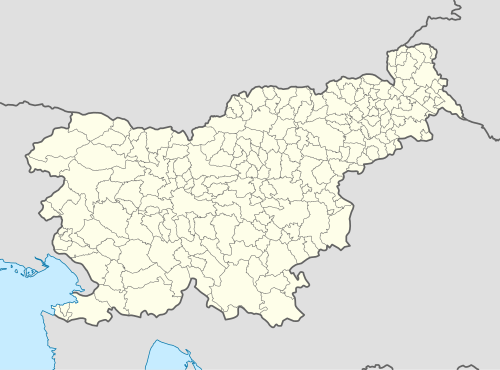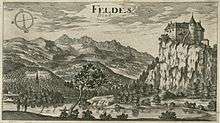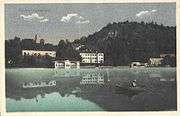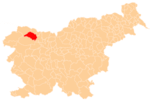Bled
| Bled | |
|---|---|
|
Lakeside, October 2006 view from the castle | |
 Bled Location in Slovenia | |
| Coordinates: 46°22′7.69″N 14°6′50.31″E / 46.3688028°N 14.1139750°ECoordinates: 46°22′7.69″N 14°6′50.31″E / 46.3688028°N 14.1139750°E | |
| Country |
|
| Traditional Region | Upper Carniola |
| Statistical region | Upper Carniola |
| Municipality | Bled |
| Elevation | 507.7 m (1,665.7 ft) |
| Population (2002) | |
| • Total | 6,322 |
| [1] | |
Bled (pronounced [ˈbleːt]; German: Veldes,[2] in older sources also Feldes[3]) is a town on Lake Bled in the Upper Carniolan region of northwestern Slovenia. It is the administrative seat of the Municipality of Bled. It is most notable as a popular tourist destination in the Upper Carniola region and in Slovenia as whole, attracting visitors from abroad too.
Name
The town was first attested in written sources as Ueldes in 1004 (and as Veldes in 1011). The etymology of the name is unknown and it is believed to be of pre-Slavic origin. The German name of the town, Veldes, was either borrowed from Old Slovene *Beldъ before AD 800 or is derived from the same pre-Slavic source as the Slovene name.[4][5]
Geography

Bled is located on the southern foot of the Karawanks mountain range near the border with Austria, about 50 km (31 mi) northwest of the state capital Ljubljana. South of Lake Bled are the densely forested Pokljuka and Jelovica plateaus, the easternmost parts of the Julian Alps. Here the Sava Bohinjka and the parallel Bohinj Railway lead up to the Bohinj basin, Lake Bohinj, and the Triglav massif.
A number of rises (Grad 599 m, Straža 646 m, Kozarca 558 m, Osojnica 756 m, and Ravnica 729 m) separate the localities of Bled around the lake, the former villages of Grad, Mlino, Rečica, Zagorice, and Želeče.
The lake is 2.12 kilometres (1.32 mi) long and 0.5 to 1 kilometre (0.31 to 0.62 mi) wide. In summer, the surface water reaches 25 °C (77 °F) and retains a temperature up to 18 °C (64 °F) until autumn. As such, it is suitable for swimming. In colder winters it freezes and is used for ice skating.
There is a thermal spring (23 °C or 73 °F) near the lake, next to the Bled Fault. Its water is used in indoor pools in two hotels.
History
Early Mediaeval history


.jpg)
A settlement area since Mesolithic times, the present-day locality probably arose about 600 during the Slavic settlement of the Eastern Alps. After the Slavic principality of Carantania was conquered by Frankish forces in 788, the area came under Bavarian influence.
Feudal estate
Bled itself, then part of the March of Carniola, was first mentioned as Ueldes (Veldes) in a document from 1004, in which German King Henry II ceded ownership of the area to Albuin, Bishop of Brixen as a sign of gratitude for the assistance the Church was giving to the king in his attempt to strengthen imperial rule in that part of northern Italy. In 1011, Henry II signed another deed of donation that added the castle and an area of land the size of thirty king’s farms. That area, between the Sava Bohinjka and the Sava Dolinka, became known as the Lordship of Veldes (German: Herrschaft Veldes). These donations marked a turning point in the history of Bled and, for the following 800 years, the area remained under the sovereignty of the prince-bishops of Brixen.
The bishops very seldom visited their remote possession 300 km away. Initially, the lordship was administered by ministeriales (bonded knights), castellans, and castle staff in accordance with feudal practices, but in the middle of the 14th century the prince-bishops decided instead to lease the estate. Under one of the 16th-century lessees, Bled Castle became a Protestant stronghold for a time. When the leasehold era came to an end, the prince-bishops began to appoint governors to manage their distant lordship. Until the middle of the 18th century, those administrators were exclusively aristocratic, but later they included non-nobles.
In 1803, Brixen’s rule came to an end when the prince-bishopric was secularized in the course of the German Mediatization. Bled then came under Austrian sovereignty but in 1808, along with Carniola, it was included in the Napoleonic Illyrian Provinces. It returned under Austrian sovereignty in 1813, and in 1838 the Austrian Emperor returned Bled to the bishops of Brixen as a private estate. With the abolition of the feudal system in 1848, Bled ceased to have the characteristics of a feudal economy and from then on it experienced several changes in ownership, including industrialists and a bank.[6][7]
After the dissolution of Austria-Hungary in 1918, Bled and the rest of Carniola came under the rule of the Kingdom of Yugoslavia and became a summer domicile of the ruling House of Karađorđević, a tradition that Yugoslav leader Josip Broz Tito continued when he built his residence here in 1947.
Modern settlement
Today's town began to form in the mid-19th century from the villages of Grad, Mlino, Rečica, Zagorice, and Želeče, which were encircling the lake. At that time, farmers started to sell the land along the eastern lakeshore to wealthy individuals for their villas, and the villages of Grad, Zagorice, and Želeče began to merge. Bled was officially recognised as a town in 1960.
Tourism
Bled is known for the glacial Lake Bled, which makes it a major tourist attraction. Perched on a rock overlooking the lake is the iconic Bled Castle. The town is also known in Slovenia for its vanilla and cream pastry (Slovene: kremšnita, kremna rezina).
Naturopath Arnold Rikli (1823–1906) from Switzerland contributed significantly to the development of Bled as a health resort in the second half of the 19th century. Due to its mild climate, Bled has been visited by aristocratic guests from all across the world. Today it is an important convention centre and tourist resort, offering a wide range of sports activities (golf, fishing, and horseback-riding). It is a starting point for mountain treks and hikes, especially within nearby Triglav National Park.
A small island in the middle of the lake is home to Assumption of Mary Pilgrimage Church; visitors frequently ring its bell for good luck. Human traces from prehistory have been found on the island. Before the church was built, there was a temple consecrated to Živa, the Slavic goddess of love and fertility. One can get to the island on a traditional flat-bottomed wooden boat (Slovene: pletna). The island on Lake Bled has 99 steps. A local tradition at weddings is for the husband to carry his new bride up these steps, during which the bride must remain silent.
Transport
The town is served by Lesce-Bled Airport.
Events
Bled hosted the World Rowing Championships for the fourth time in history in 2011. It previously hosted the championships in 1966, 1979, and 1989.[8]
In 1961 the Grand Hotel Toplice in Bled was the site of one of the most important international tournaments in chess history. In 2002, the 35th Chess Olympiad was held in the city.
City hosts one of the big lindy hop events, swing bled
Notable people
Notable people that were born or lived in the Bled include:
- Iztok Čop (born 1972), rower, multiple Olympic medalist[9]
- Peter Florjančič (born 1919), inventor and Olympic athlete
- Špela Pretnar (born 1973), skier, Olympic athlete
International relations
Twin towns/Sister cities
Bled is twinned with:
See also
References
- ↑ Statistical Office of the Republic of Slovenia
- ↑ Leksikon občin kraljestev in dežel zastopanih v državnem zboru, vol. 6: Kranjsko. 1906. Vienna: C. Kr. Dvorna in Državna Tiskarna, p. 146.
- ↑ de Luca, Ignaz. 1790. Geographisches Handbuch von dem östreichischen Staate, vol 2. Vienna: Johann Paul Krauß, p. 137.
- ↑ Snoj, Marko. 2009. Etimološki slovar slovenskih zemljepisnih imen. Ljubljana: Modrijan and Založba ZRC, p. 65.
- ↑ Bezlaj, France (ed.). 1977. Etimološki slovar slovenskega jezika, vol. 1, A–J. Ljubljana: SAZU, p. 26.
- ↑ http://www.bled.si/en/about-bled/the-history-of-bled
- ↑ "Archived copy". Archived from the original on 2015-06-14. Retrieved 2015-06-13.
- ↑ Archived April 12, 2011, at the Wayback Machine.
- ↑ "Iztok COP | Olympic Athlete | Athens 2004, Atlanta 1996, Barcelona 1992, Beijing 2008, Innsbruck 2012, London 2012, Sydney 2000". Olympic.org. Retrieved 2013-03-26.
External links
| Wikimedia Commons has media related to Bled. |
| Wikivoyage has a travel guide for Bled. |


